Background
Mangbetu are a tribal group of people living in the Democratic Republic of the Congo in the Orientale Province. They speak a language called kingbetu, part of the regional Lingala language (a member of the Central Sudanic linguistic family). The Mangbetu call their language Nemangbetu. (1)
The Mangbetu are well known for their highly developed music and art. The most famous being the Mangbetu harp or guitar. Exemplary versions have sold for well over $100,000! They are often adorned with carved figures of wood or ivory with exceptionally detailed carving. Their music has been widely studied by musicologists as well. (2)
The uniqueness of the Mangbetu has always fascinated European explorers. By tradition, the Mangbetu have wrapped the heads of infants in tightly wrapped cloth to give them a distinctive elongated shape to the skull. Although the practice began to die out around 1950, it is still traditionally practiced as it is considered a sign of great beauty today to the Mangbetu and it does make the Mangbetu figures easy to identify in art and sculpture. (3)
Tribal Facts
The Mangbetu had consisted of a number of small clans who, from southward migrations in the early 1700’s, had come in contact with a number of northward-migrating Bantu-speaking tribes among whom they lived. In the late 18th century a group of Mangbetu-speaking elites, mainly from the Mabiti clan, assumed control over other Mangbetu clans and many neighboring Bantu-speaking tribes. It is likely that their knowledge of iron and copper forgery, by which they made weapons and fine ornaments, gave them a military and economic advantage over their neighbors. (4)
Notoriety?
The mystique of the ancient Mangbetu revolves around the fact that the Mangbetu are considered to be a historically cannibalistic people. This fact was emphasized in a documentary called Spirits of Defiance: The Mangbetu People of Zaire. “David Lewis asserts that a “wave of flesh-eating that spread from inveterate cannibals like Bakusa to Batetela, the Mangbetu, and much of the Zande” resulted from ongoing political disorder caused by Swahili raids in the . However, Keim contends that many of the accounts of cannibalism are not based on “careful fieldwork in Africa but on nineteenth-century European accounts that were deeply prejudiced by Dark Continent myths.” ” (5)
The Pottery
Pottery produced by the Mangbetu was classified as three types: the large pot (also known as nembwo), the small pot, and sculpted and decorated pots. The nembwo served general purposes, such as getting water from the lake and carrying vegetables. The smaller pots were used for more specific tasks such as cooking, cleaning, and pouring, and some were even used as toilets. The decorative pots were made more as a hobby, and nowadays are collector’s items and can fetch a high price in art auctions. (6)
The nembwo and small pot have a rather round conventional pot shape that is more spherical than most due to how it is constructed, and most are thin and smooth with a thicker opening. The decorated and sculpted pots of the Mangbetu tribe have human or animal figures (generally just heads) at the opening of the jar. Occasionally this sculpted figure is a Mangbetu woman with the traditional elongated head and decorative head dressing. The handles of these pots are sometimes molded into animal or human parts. The bottom of the pot is round, and occasionally patterns will be carved onto the surface. The pots are monochromatic and are made of coarse textured clay which is either hand built or made using variations of the “hammer-and-anvil” technique. They are usually a natural russet color or dark gray (the decorative pots). The latter often have incised patterns on the surface in addition to the human or animal figures. The surfaces are textured using shell scrapers and wooden pattern-making tools and then the pots are fired in open bonfires. (7)
Terracotta Mangbetu Pot #1
Terracotta Mangbetu Pot #2
Terracotta Mangbetu Pot #3
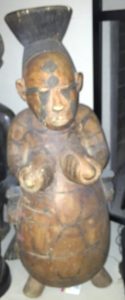
Wooden Mangbetu Sculpture– Man and Woman
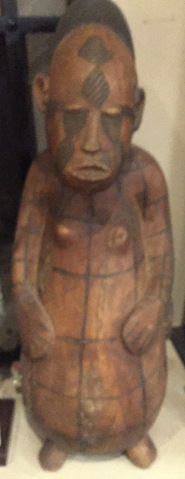
All items from the collection at Spectrum Arts
SOURCES
(1) (2) (3) (4) (5)
Mangbetu People
sourced from:
- Christopher Ehret, The Civilizations of Africa: A History to 1800(University of Virginia Press, 2002), 436–438.
- Curtis A. Keim, Mistaking Africa: Curiosities and Inventions of the American Mind(Basic Civitas Books, 1999), 42–43, 92–93.
- David Levering Lewis, The Race to Fashoda: European Colonialism and African Resistance in the Scramble for Africa(New York: Weidenfeld and Nicolson, 1987).
(6) (7) Mangbetu Pottery sourced from:
- “Pottery”. edu. Retrieved 2015-03-05.
- “Mangbetu Terracotta Statue Pair Antique African Tribal Art – eBay”.com. Retrieved 2015-03- 05.
- “Mangbetu Clay Pot – Congo”. Ezakwantu.com. Retrieved 2015-03-05.
- “The Congo Expedition: Art of Daily Life”. org. Retrieved 2015-03-05.
Phillips, Ruth B., and Christopher Burghard Steiner. Unpacking culture art and commodity in colonial and postcolonial worlds. Berkeley: University of California Press, 1999. Print.

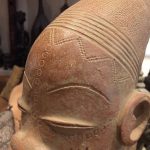
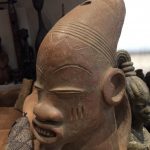
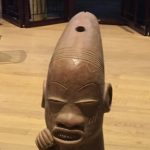
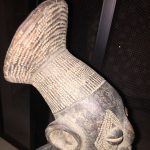
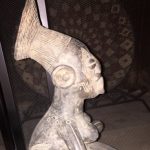
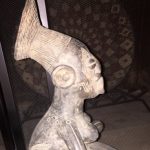
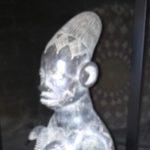
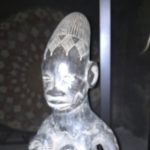
Recent Comments